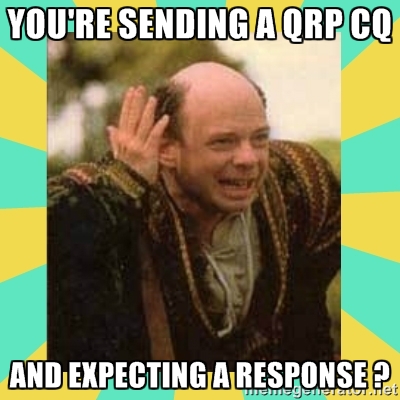Posts Tagged ‘amateur-radio cw’
 Which antenna is better?
Which antenna is better?
Real world antenna comparisons
I don't have many choices for my antenna at my residential QTH. I have an 80m OCF Dipole (aka Windom) hung from the peak of my roof at about 25ft and a ladder line fed 40m Doublet folded around in my attic at about the same height.
Generally I've been using my 80m Windom for most contacts because it is resonant on 7 bands and I don't have to tune it. I've had a number of on-air ragchews where I switch antennas and ask for signal reports but it is often a hassle and I don't like to interrupt a ragchew to ask for that sort of comparison.
So how do I know which antenna is better for certain bands and directions?
The RBN
The Reverse Beacon Network offers an objective and patient antenna tester. I just recently learned about this resource and it's a fabulous tool. When my CQ isn't being answered I'll often bring up the RBN and check my signal reports and then switch antennas to see how they compare.
It has been very interesting to learn that the Doublet in the attic often outperforms my Windom usually by 12db and sometimes by as much as 20db especially on the higher bands. I'm guessing that part of it is the greater efficiency in the ladder line but that doesn't tell the whole story because the Windom offers a low SWR on most bands and shouldn't be eating up much power in the coax through SWR losses. Antennas are magic.
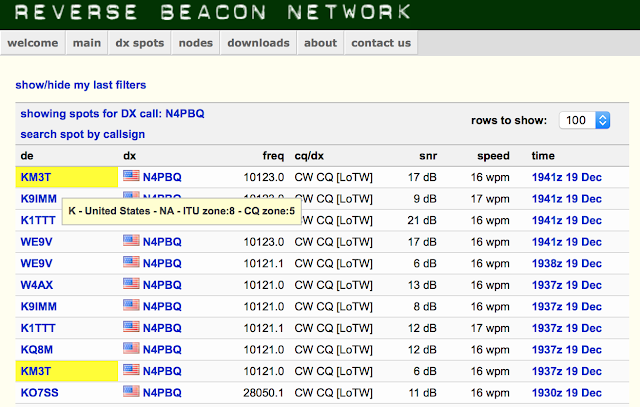 |
| Two highlighted records show the difference when I switched antennas and moved the transmit frequency slightly to cause a new report to be sent |
Process
Ok so here's what I do... The RBN stations will report only when they see a new frequency or it's been 15 minutes since the last report for a given station, so when I switch antennas I will move frequency slightly to trigger the new report. Now admittedly QSB or other conditions may change between the reports so you'll need to do this a bunch of times over the course of days and compile some records to get a clear idea of how each antenna is performing in certain directions. This isn't hard science but it's more real-world than a smith chart or the occasional signal report from a station or two.
If you make use of the RBN I encourage you to donate on their site.
That's all for now...
So lower your power and raise your expectations
72/73
Richard N4PBQ
 Can anybody hear me
Can anybody hear me
Calling QRP CQ - Inconceivable
My 80m OCF Dipole has been a surprisingly good antenna and I've made contacts with it on all bands except 6m and 160m. Based on my past experience trying to tune up short antennas on 160m I really hadn't considered trying to use this Windom for 160m. But through some email exchanges with another ham in Illinois who had recently put up a 160m antenna we decided to try a scheduled QSO on the top band. So it was time to give the Windom a shot on 160m.
Amazingly my 80m Windom / OCF Dipole has 4.5:1 SWR native around 1.8 mHz and it matches easily with a tuner across the entire 160m band. That was a surprise.
Amazingly my 80m Windom / OCF Dipole has 4.5:1 SWR native around 1.8 mHz and it matches easily with a tuner across the entire 160m band. That was a surprise.
I tossed my mighty 5 watts call out at 1810 kHz not expecting much...
Within a minute of calling CQ I had a faint QRP station from Maine tried to work me. After about 4 tries I finally copied his call correctly but then lost him. Immediately another station called me and we exchanged the niceties of signal reports, location, rigs and weather. I received a nice 579 report for my 5w and I gave him a 599+ report for his thundering kilowatt station. He needed to work my County so I was glad to be able to provide him with the contact. Following that call the former QRP station from Maine was back in there and finally we worked each other. We had a nice QRP to QRP QSO on the top band. He gave me a 549 report but he was using a 400 ft beverage receive antenna. I was struggling a bit more to copy him through local QRM on my side and a less qualified receive antenna and reported his signal as 339.
Those were my first two contacts on 160m using CW. Who'd have thought my cloud burner antenna and QRP power would get me such quick results on the top band. I just figured no one would hear me.
So how do you know if and where your signal is getting out ?
The Reverse Beacon Network
I had to quit right after those two QSOs but when I later checked my email the original station with whom I'd planned the scheduled QSO reported that although he had not heard me he said I was getting out and sent me a link to something called the reverse beacon net showing a couple of stations that were hearing me on 1810 kHz.
You mean I can find out in near realtime if and where my signal is being heard by an automated system? No way! That is cooler than a Ronco Pocket Fisherman. Recall that I'm relatively new at this stuff and this may be old hat for a lot of you. But the ability to toss out your call and in real-time check where your signal is getting to just warms the push-pull final transistor in my heart.
The Reverse Beacon Network can give you the last 100 reports of your station. So I took a look and saw some of my weekend activity where I was shooting some fish in a barrel (I mean working contest stations) and there were beacon reports of my call from such places as far South as the Antilles and as far West as Utah.
| Map of the last 100 reports from Reverse Beacon stations of my call sign Color coded by band |
So the reverse beacon network report tells you what station heard you, the frequency, the signal to noise ratio (higher is better) and your word per minute (wpm) speed.
It even includes a speedometer
Being a new CW dude my word per minute speed is of interest to me. Most of my QSOs in the past week have been at 15-16 wpm. I'm using a Vibroplex Bug I received last weekend and have slowed it down with a home-made weight attached to a drywall anchor pressed on the end of the pendulum. I found it interesting that some beacon stations reported me at 19-23 wpm. I looked at the time and the frequency and realized that the higher speed was from my first on-air QSO using the Vibroplex Bug with N4HAY before I slowed it down with my junk box bug tamer.
| My brief speed key session with N4HAY |
So if you are using a manual key and don't know what speed you are sending just check out a beacon to see what speed they are reporting.
Summary
This reverse beacon stuff has been around a while. So unless you're a newbie like me you probably already knew about it. But if you haven't used before it's very cool, especially with regard to knowing how your QRP station is being heard. Are you making it 1000 mile per watt? Is your antenna propagating East, West, North or South. How and where is the skip? This answers many questions that I had been wondering about as I'm operating. A shiny new toy, just in time for Christmas
So that's all for now.
So lower your power and raise your expectations
73/72
Richard N4PBQ
 DX seems to operate in the fast lane
DX seems to operate in the fast lane
DX for new CW operators
How to copy those high speed ops?
 |
| EA8TL's Hexbeam in the Canary Islands |
Well this morning I wasn't having much success getting an answer to my calls on 40m, and 20m seemed dead. So I popped up to 17m and there was a good signal coming in that no one else was answering. I listened over and over and finally copied EA8T (op name Jorge) located in the Canary islands off the coast of Africa. I replied to him and worked him at my relatively slow 18wpm sending speed. I wasn't very graceful in my response and he got my call wrong on the first go 'round but resent it correctly after that. The entire time no-one else answered him even though there was plenty of activity elsewhere on 17m. Are the Canary Islands considered blasé as far as DX?
Anyway I was happy to get the response. I know (or surmise) that my 80m Windom has some fairly pronounced gain nodes in different directions on the higher bands but I didn't know which directions they pointed. I guess one of the nodes points toward Africa (yaaay!)
My copy speed is slowly increasing as I've been operating CW for about 3 months now, but I wonder if there are DX stations on some segments of the band plan for slower speed operations. I spent about 20 minutes sending my call at 18wpm down to 12wpm on the QRP segment of 17m (18.096 MHz) but no one answered. I know I was getting out given the previous contact.
So lower your power and raise your expectations
73/72
Richard N4PBQ
Anyway I was happy to get the response. I know (or surmise) that my 80m Windom has some fairly pronounced gain nodes in different directions on the higher bands but I didn't know which directions they pointed. I guess one of the nodes points toward Africa (yaaay!)
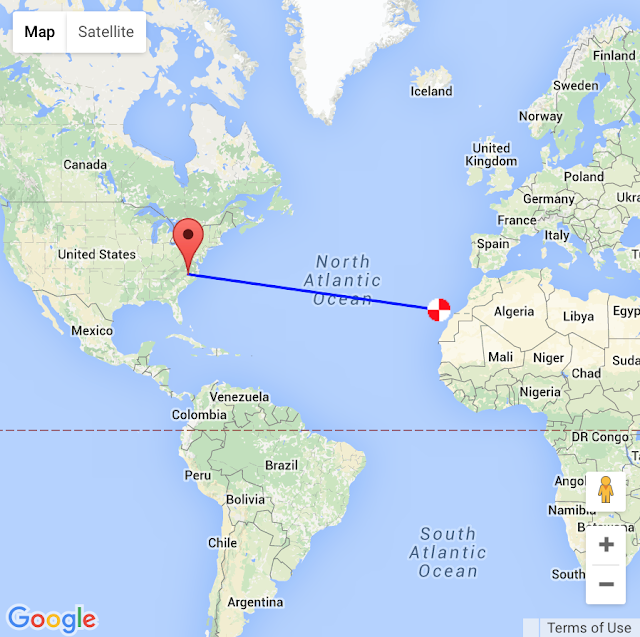 |
| Path from N4PBQ to EA8TL in the Canary Islands |
Do DX operators just not want to bother with newbies such as myself? I wonder. I'd appreciate suggestions in the comments section.That's all for now
So lower your power and raise your expectations
73/72
Richard N4PBQ
 Rock ‘N Radio — QRP Style
Rock ‘N Radio — QRP Style
Operating QRP
Can mean operating from a "Quiet Restful Place"
I had the day off today and it was a beautiful morning. I decided to spend part of it at Lake Wheeler Park in Raleigh, NC operating QRP from a stone bench under a tall oak tree. |
| rock 'n radio |
I threw a line over a tree using a throwing weight. I hit my mark the first time, untied the weight, tied on the end of the antenna, and hoisted the 31 foot end-fed up exactly where I wanted it with the feed point a couple of feet off the ground.
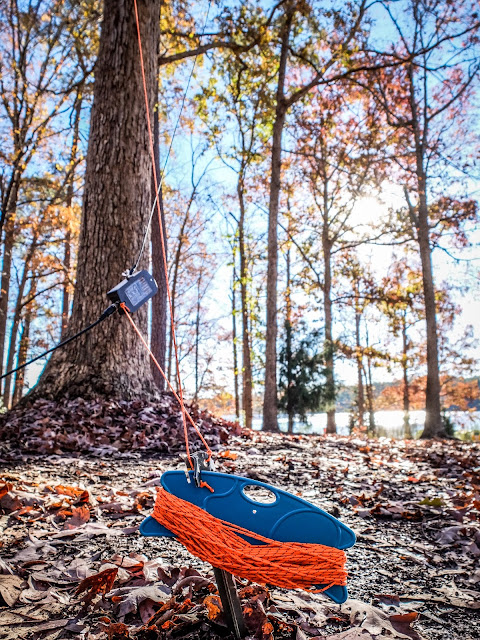 |
| 31 feet of wire end-fed by a 9:1 balun. A kite string winder holds the throwing line A metal stake with a bit of rope anchors the balun and the other end of the rope |
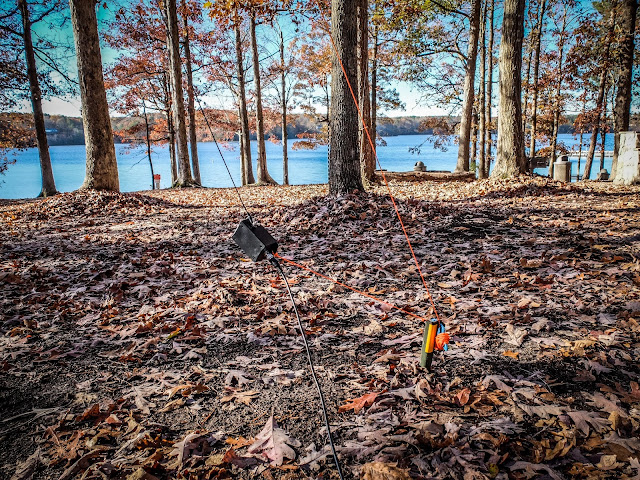 |
| Another view of the end-fed with 9:1 balun, stake and coax |
 |
| QRP operating position |
The KX3 will match the end-fed wire on about any band other than 160m but on 80m you could likely throw the radio farther than the signal travels. The KX3 auto tuner is pretty amazing and I believe it could tune a piano if you hooked it up correctly.
I worked stations on 20m, 40m and 30m.
I called CQ on the 20m QRP calling frequency (14.060) and had a brief QSO with a lot of QSB (fading). I didn't hear much activity that early in the morning on 20m so I dropped down to 40m and worked the QRP calling frequency (7.030) and had my call answered right away. After that QSO another station jumped in there calling for a specific station so I moved on. 40m was busy. Every time I thought I'd found an open frequency someone would jump back in or if I called QRL? I'd get an R R.
I called CQ on the 20m QRP calling frequency (14.060) and had a brief QSO with a lot of QSB (fading). I didn't hear much activity that early in the morning on 20m so I dropped down to 40m and worked the QRP calling frequency (7.030) and had my call answered right away. After that QSO another station jumped in there calling for a specific station so I moved on. 40m was busy. Every time I thought I'd found an open frequency someone would jump back in or if I called QRL? I'd get an R R.
So I went up to 30m, and had a very nice long ragchew that lasted nearly an hour. The internal AA batteries on the KX3 were getting a workout operating at 5w for that entire time but I never saw the transmit wattage drop below 5w and when I finished up the internal batteries still showed 9.8 V The cutoff is 8.5 V so there was plenty of juice left. I may just stop carrying the external battery on these brief jaunts.
My long ragchew was with a station in GA about 400 miles away and he gave me a report of 599 so I was thrilled with 30m this morning. Coincidentally, this end-fed antenna, balun, coax-counterpoise combo is nearly resonant on 30m and I've had some of my best reports when operating this portable antenna on 30m.
Key wise, I was using the Palm Single Paddle. It is a great little key when you don't have a table to operate from and you don't want to strap something to your leg. I get strange enough looks from passer-by's without them wondering why I have some mechanism strapped to my thigh and the Palm Single is very inconspicuous.
The Palm key has a clip-on, magnetic base which I use to temporarily attach it to my clipboard when I'm not sending. When I'm ready to send I simply pull it off the clipboard and hold it in my left hand. As I noted in an earlier review of the Palm Single Paddle it can be used as a straight key if you turn it on its side. The long ragchew I had on 30m was with a gentlemen who sent me his SKCC number in the first exchange so I quickly turned off the electronic keyer in the KX3's and turned the Palm Single on its side. That station sent me a nice compliment on my straight key FIST; so the little Palm Single key can serve duty as a paddle into a keyer or (in a pinch) as a straight key. I far prefer to use my Kent Hand Key if I'm operating manual key but it's too big to bring along for portable operations and I can't quite picture myself trying to hold onto the giant Kent Hand Key with one hand whilst operating it with the other like I can the Palm Single.
The Palm key has a clip-on, magnetic base which I use to temporarily attach it to my clipboard when I'm not sending. When I'm ready to send I simply pull it off the clipboard and hold it in my left hand. As I noted in an earlier review of the Palm Single Paddle it can be used as a straight key if you turn it on its side. The long ragchew I had on 30m was with a gentlemen who sent me his SKCC number in the first exchange so I quickly turned off the electronic keyer in the KX3's and turned the Palm Single on its side. That station sent me a nice compliment on my straight key FIST; so the little Palm Single key can serve duty as a paddle into a keyer or (in a pinch) as a straight key. I far prefer to use my Kent Hand Key if I'm operating manual key but it's too big to bring along for portable operations and I can't quite picture myself trying to hold onto the giant Kent Hand Key with one hand whilst operating it with the other like I can the Palm Single.
 |
| The Palm Single Paddle works great in portable operating positions |
I made a silly little video of my trip to the park...
So enjoy some nice fall weather if you still have it and have a Rock 'N Radio adventure.
 |
| What could be finer than to be in Carolina in the Mooo-oor-ning |
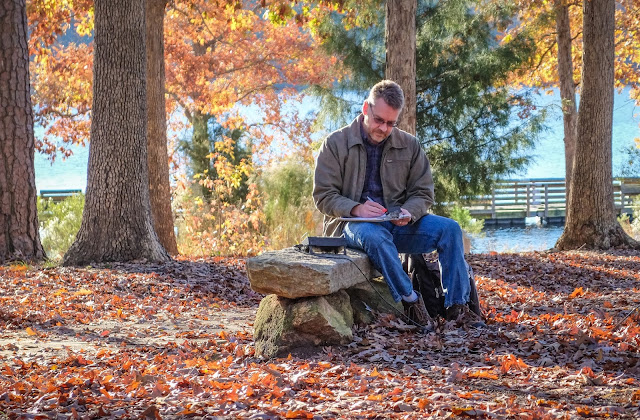 |
| Enjoying the last nice days of our Fall... birds singing and morse code beeping |
That's all for now...
So Lower your power and raise your expectations
73/72
Richard N4PBQ
 The Perception of Power
The Perception of Power
Power... or lack thereof
I had a good afternoon playing radio on 40m, 30m, 20m and 17m
I like 30m because that band seems to be more laid back and I seem to have some of the longest ragchews there. One of the QSOs began with a fellow in CT using a K2 at 80w while I was running 5w.
As the QSO progressed he was surprised by how well he could hear a QRP station. This seems to be repeated often enough to me that I asked him to lower his power and see how it goes.
He lowered his power from 80w to 50w and I gave him a signal report that didn't differ from his original. Then he came down to 20w and I dropped him a point. Eventually he lowered his power down to 5w while I went to about 1w. We continued to have our QSO although QSB started to make copy difficult but the main thing was that he was very surprised that he could come down to 5w and have me hear him and that he could still copy me at 1w. We were both using wire antennas and he was about 500 miles north of me. Solar Flux was only 107 today so it wasn't particularly stellar (pun intended) and it wasn't grey line by any means.
I think QRP operators should encourage QRO operators to try lowering their power just as an experiment. After all we are supposed to use just enough power for communication, rather than all that we can generate. I generally start at 5w and if a station is having difficulty or gives me a 339 I'll turn it up to my scorching 12w.
Save power, save the planet. Maybe we can design a CW key that generates enough power to run our milliwatt rigs.
So lower your power and raise your expectations
73 es 72
Richard
N4PBQ
